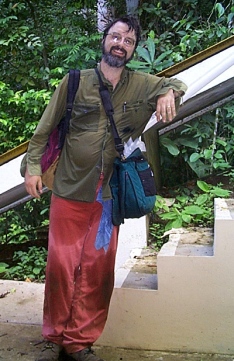
Every once in a while its good to take a step back, look to the horizon, and figure out the principles that got you where you are. Call it a mission statement or what have you, when I put together my first webpage in the mid 90’s, I wrote a manifesto. Which is now updated. You’ll have to check it out to see what went before (accompanied by the above photo of me collecting army ants). But here is V 2.0, written 17 years later.
After 17 years, it is time to update the manifesto. Much has changed. The beard is now grey; the “Coon hunter’s special” hooked up to the motorcycle battery has been replaced by a Penz with 10 LEDs; and I seriously doubt I could achieve, let alone maintain, the above posture. Mind you, the old manifesto (below) is still valid. It just needs a little updating. If it seems a bit more operational, and little less aspirational, re-read number 1; 2-6 are a roadmap toward achieving it.
1) Change the world. Why else are we here? The world could use some help right now.
2) Always be finishing something. Wonderful advice, courtesy of Dan Janzen. It is always easier to begin a project than it is to wrestle it from 95% complete to over the finish line.
3) Quality = style * content. Style makes content go down easy; content makes it satisfy.
4) Teaching = Writing. A corollary to 3. Writing is not dumping your thought processes onto the page. Good writing, as David Foster Wallace says, is considerate. It is empathetic. Know your audience and write for them.
5) Become the authority on something. The joy, and the responsibility, of scholarship is in becoming the go-to person on something that the world cares about (or should care about, see 1).
6) Work is play. Academia is hard, science is hard. But where else can you discover something truly new? We are the lucky ones: we exist in a civilization that values discovery. Keep the long view, and cherish those moments of transcendence.



 Posted by pheidole
Posted by pheidole 


